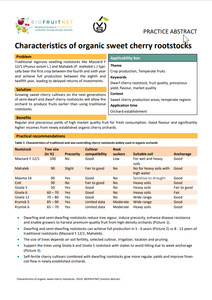{Tool} Characteristics of organic sweet cherry rootstocks (Biofruitnet Practice Abstract). Creator(s): Vávra, Radek; Kaplan, Jiří and Jan, Tomáš. Issuing Organisation(s): VSUO - Research and Breeding Institute of Pomology Holovousy. Biofruitnet Practice Abstract, no. 080. (2022)
|
PDF
- Published Version
- English
(Characteristics of organic sweet cherry rootstocks)
328kB | |
![[thumbnail of 2022-07-01 14_14_51-Characteristics of organic sweet cherry rootstocks.png]](/44241/3.hassmallThumbnailVersion/2022-07-01%2014_14_51-Characteristics%20of%20organic%20sweet%20cherry%20rootstocks.png)  Preview |
Image (PNG)
- Cover Image
- English
123kB |
|
PDF
- Published Version
- Slovak/Slovenčina
(Charakteristika ekologických podpníkov čerešní)
334kB | |
|
PDF
- Published Version
- Czech/Česky
(Charakteristika sortimentu podnoží třešní pro ekologické pěstování)
340kB | |
|
PDF
- Polish/Polski
(Charakterystyka podkładek dla czereśni przydatnych do produkcji ekologicznej)
335kB |
Document available online at: https://orgprints.org/44241
Summary in the original language of the document
Regular and precocious yields of high market quality fruit for fresh consumption. Good flavour and significantly higher incomes from newly established organic cherry orchards.
• Dwarfing and semi-dwarfing rootstocks reduce tree vigour, induce precocity, enhance disease resistance and enable growers to harvest premium-quality fruit from high-density orchards.
• Dwarfing and semi-dwarfing rootstocks can achieve full production in 5 - 6 years vs 8 - 12 years of traditional rootstocks (Mazzard F 12/1, Mahaleb).
• The size of trees depends on soil fertility, selected cultivar, irrigation, location and pruning.
• Support the trees using Gisela 6 and Gisela 5 rootstock with stakes to avoid tilting due to week anchorage.
• Self-fertile cherry cultivars combined with dwarfing rootstocks give more regular yields and improve financial flow in newly established orchards.
• Avoid the most dwarfing rootstocks (Gisela 5 and Krymsk 6) in shallow and low fertile soils.
• Check with advisors that the size-controlling rootstocks chosen for new plantings fit to the desired tree density, soil and climatic conditions.
• Size-controlling rootstocks allow pedestrian orchards with easier and safer management and a more productive working environment.
| EPrint Type: | Practice tool |
|---|---|
| What problem does the tool address?: | Traditional vigorous seedling rootstocks like Mazzard F 12/1 (Prunus avium L.) and Mahaleb (P. mahaleb L.) typically bear the first crop between the fourth and sixth year and achieve full production between the eighth and twelfth year, leading to delayed returns of investments. |
| What solution does the tool offer?: | Growing sweet cherry cultivars on the next generations of semi-dwarf and dwarf cherry rootstocks will allow the orchard to produce fruits earlier than using traditional rootstocks. |
| Country: | Czech Republic |
| Type of Practice Tool: | Practice abstracts |
| Keywords: | Dwarf cherry rootstock, fruit quality, precocious yield, flavour, market quality |
| Agrovoc keywords: | Language Value URI English flavour http://aims.fao.org/aos/agrovoc/c_10893 English cherries http://aims.fao.org/aos/agrovoc/c_1534 English temperate fruits http://aims.fao.org/aos/agrovoc/c_7655 |
| Subjects: | Crop husbandry > Production systems > Fruit and berries |
| Research affiliation: | European Union > Horizon 2020 > Biofruitnet Czech Republic > Other institutions Czech republic European Union > Organic Farm Knowledge |
| Horizon Europe or H2020 Grant Agreement Number: | 862850 |
| Related Links: | https://organic-farmknowledge.org/tool/44241, https://biofruitnet.eu, https://twitter.com/farm_knowledge/status/1542865636262543361, https://www.facebook.com/organicfarmknowledge/posts/pfbid0255CANVXh2YJBg1S5NcmsVd2rPZpANmpYaxQuVAiTUmuCgrmcG1CZ1hxSRPnnfP49l |
| Project ID: | ofk |
| Deposited By: | Basler, Andreas |
| ID Code: | 44241 |
| Deposited On: | 29 Jun 2022 16:06 |
| Last Modified: | 02 May 2024 10:32 |
| Document Language: | English, Czech/Česky, Polish/Polski, Slovak/Slovenčina |
| Status: | Published |
Repository Staff Only: item control page

 Download Statistics
Download Statistics Download Statistics
Download Statistics
